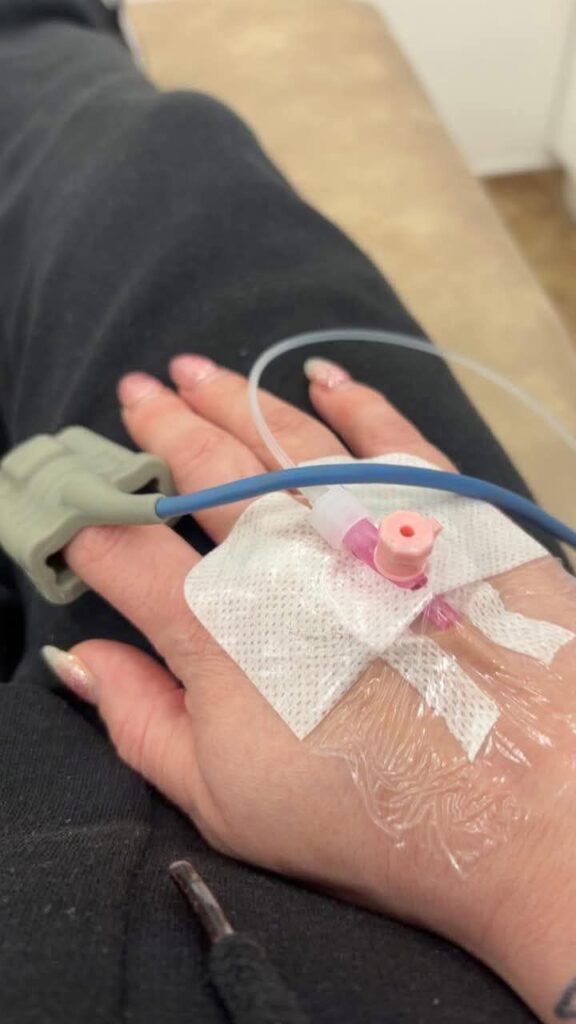By Gina Roberts-Grey
With fibromyalgia syndrome, just getting by each day often requires difficult choices. Read on for expert advice on managing fibromyalgia pain and fatigue while living life to the fullest…
Life with fibromyalgia is full of ups and downs. One day you’re fine, able to handle everything on that mile-long to-do list. The next, you’re so tired you can’t get out of bed to feed the kids.But even with such uncertainty, you can take steps to avoid fibromyalgia pain. “If a woman with fibromyalgia spends too much time stressing about her condition, she uses up precious energy,” says Scott Glaser, M.D., a Chicago-area interventional pain specialist and diplomate of the American Board of Interventional Pain Physicians. Learning to treat yourself well can mean the difference between controlling fibromyalgia symptoms and letting them control you, says internist Jacob Teitelbaum, M.D., author of several books on fibromyalgia, including The Fatigue and Fibromyalgia Solution (Avery 2013). “Life’s ‘little things’ can impact fibromyalgia,” he says. “What your friends or family members do to stay healthy might not be appropriate for [you].”
These 14 doctor-recommended do’s and don’ts will help you get rid of guilt, pace yourself on difficult days and sidestep stress when fibromyalgia symptoms flare:1. Do listen to your body.
Take a “time out” if you need one.“Too many women fight through fibromyalgia fatigue instead of resting,” Dr. Teitelbaum says.Fatigue is the body’s way of telling you to take it easy, he adds. “Pushing through exhaustion can worsen fibromyalgia symptoms and leave you feeling more sluggish.”2. Don’t always put others first.
It’s natural to put kids’ needs before your own.“But moms with fibromyalgia shouldn’t let parenting responsibilities prevent them from making healthy choices,” Dr. Glaser says.That means: Don’t skip a doctor’s visit to attend your child’s recital.“[It] won’t help anyone,” he says. “Taking care of yourself will make it easier to care for your family.”Don’t let fibromyalgia ruin your relationship with your family. These fibromyalgia management tips to reduce guilt, increase quality time and get things done around the house.
3. Do make good use of the energy you have.
It’s easy to fall into the I-can’t-do-that mindset, says Southern California psychotherapist Tina B. Tessina, Ph.D., author of It Ends With You: Grow Up and Out of Dysfunction and The Ten Smartest Decisions a Woman Can Make After Forty (CreateSpace Independent Publishing Platform).“But don’t use fibromyalgia as an excuse [to avoid activities],” she says.Or underestimate your capabilities when you’re feeling good.That attitude makes you a victim.If you’re feeling well, do what you can for as long as you can.4. Don’t overdo it on good days.
But don’t “make up” for lost time on days that you’re pain- and fatigue-free.“Trying to do too much when you feel great can trigger a flare,” says David Edelberg, M.D., a Chicago integrative-medicine specialist and author of The Triple Whammy Cure (Atria). “Even if you’re feeling good and have plenty of energy, your muscles are still susceptible to soreness.”So don’t tackle a long to-do list. Instead, set a goal to do one thing you were unable to do when battling fibromyalgia pain, he suggests.“That way, you can enjoy the feeling of accomplishment without the ‘pain hangover.’”
5. Do learn to say no.
Have too much on your plate? Don’t let nonessential obligations, such as baking cookies for your kids’ school event or hosting a big family dinner, stress you out.Just say no. And don’t feel guilty about it, either.“But try not to change your routine completely,” recommends the Mayo Clinic. People who quit work or drop all activity tend to do worse than do those who remain active.”6. Don’t just sit around.
It might be tempting to just veg out. But regular exercise, like yoga or walking, keeps flares at bay.Do enough to feel good, but not so much that it wipes you out the next day, Dr. Teitelbaum says.“If you feel ‘bad tired’ – like you were hit by a truck – you overdid it,” he says.The easiest way to start exercising? Take a daily walk for as long as feels comfortable, Dr. Teitelbaum says. Then add one minute every 7-10 days.Use a pedometer to track progress and increase gradually until you’re taking 10,000 steps a day (the amount many fitness programs recommend for good health), he says.Don’t be afraid of going farther either.“If you feel up to it, don’t stop at 10,000 steps,” Dr. Teitelbaum adds. “Walk longer as long as you’re not too tired the next day.”Light to moderate exercise will not worsen your pain, and may even improve your fibromyalgia symptoms, according to a 2013 study from Wake Forest Baptist Medical Center, published in the journal Arthritis Care & Research.The study found that participants who engaged in light jogging or brisk walking for 20 minutes daily for at least 12 weeks showed greater improvements in clinical symptoms, compared to participants who didn’t participate in the physical activity.Yoga has been shown to improve fibromyalgia pain and anxiety, and improve sleep, according to a 2010 study from Oregon Health and Science University in Portland. These yoga exercises will help you get started.But don’t start any exercise regimen until you get your doctor’s OK.
7. Do keep your mind busy.
If you don’t have the energy to take a walk or do household tasks, stay mentally active instead, Dr. Teitelbaum suggests.That means working a crossword puzzle or Sudoku, playing a stimulating game with your kids, or watching a thought-provoking movie.These activities can relieve stress, and prevent excess worrying and fibro fog, he says.“Taking your mind off pain – even for an hour or two – can help your body relax and reduce fibromyalgia symptoms,” Dr. Teitelbaum says.
Walking Workouts: 9 Myths and Facts to Know
8. Don’t focus on fibromyalgia.
Excessive worrying about your next fibromyalgia flare increases stress levels, which worsens how you feel, Dr. Edelberg says.In the middle of a flare, focus on something positive instead – a funny scene from a movie or a relaxing trip you once took, he says.“Sometimes [just] telling yourself you’ll feel better can spark a remission,” Dr. Edelberg says.By focusing on something other than the pain, he explains, you may actually feel it less.
9. Do ask for help.
On bad days, as your friends or family to lend a hand, for example to take the kids to school or run an errand.“People volunteer to help because they legitimately want to,” Tessina says.And you’ll get much-needed time to focus on feeling better, she says.
10. Don’t clam up.
Share your disorder with family and friends, Dr. Glaser says.“Tell them how you feel on good and bad days, so they know what you’re going through,” he suggests.Talking about your condition may help relieve the stress that can worsen fibromyalgia symptoms, according to the American Academy of Rheumatology. And it can help loved ones understand how to support you.“You need to surround yourself with people you can count on if you need an encouraging word or a distraction from pain,” Dr. Glaser says.
11. Do stick to a schedule.
Maintain normal daily routines and activities, Dr. Glaser says.Routines make it easier to identify your energy levels, so you can plan the best times to play with your kids, go to lunch with a pal or tackle cleaning out a closet.“Try to exercise, take supplements and go to bed at the same time every day,” he suggests.12. Don’t listen to negativity.
Avoid people who can’t – or won’t – acknowledge your fibromyalgia symptoms.That includes unsupportive doctors.If your doctor dismisses your symptoms, find another one who believes in you and will work with you to help reduce your pain and fatigue, advises the Fibromyalgia Network, an online support group.
13. Do question your doctor.
After you find a doctor who specializes in treating fibromyalgia patients, ask a lot of questions.For example, a doctor can help you decide which medications for fibromyalgia may be right for you. Among those are anti-inflammatory drugs for pain, opioids, and anti-depressants, including tricyclics or serotonin reuptake inhibitors (SSRIs), such as Zoloft, for mood and energy. Also ask about alternative treatments like massage, acupuncture and biofeedback, which some people find effective in reducing fibromyalgia pain, Dr. Glaser says.Biofeedback is a relaxation technique that teaches you to control heart rate or muscles using electrical sensors attached to your body, according to the Mayo Clinic. With the help of sensors and a therapist, you learn how to calm or regulate your bodily functions. And ask your doctor if nutritional supplements such as B vitamins, ribose or magnesium could help boost your energy levels, Dr. Teitelbaum adds.(For more on what to discuss with your physician, see Talking to Your Doctor About Fibromyalgia.)
14. Don’t shut down.
When you aren’t feeling well, you may feel like hiding in your bedroom. But that will make you feel worse, not better, Tessina says.Staying connected with friends and loved ones gives you vital support, even when symptoms make life difficult, she says.If you aren’t well enough to go out, have them visit you, Tessina suggests. Even connecting via phone or the Internet can help you feel more in control.
reference<https://www.everydayhealth.com/fibromyalgia/dos-donts-living-with-fibromyalgia-pain/



